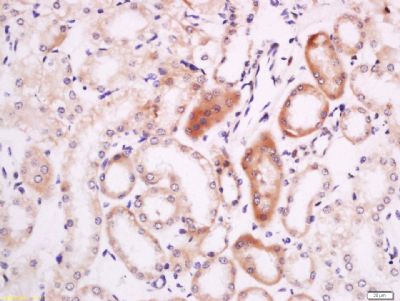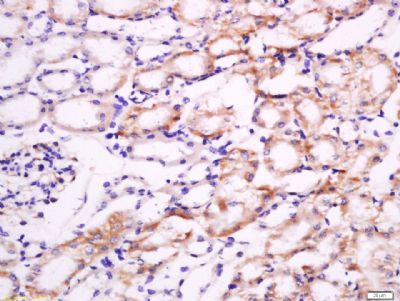
TET2,甲基双加氧酶TET2抗体
产品名称: TET2,甲基双加氧酶TET2抗体
英文名称: Anti-TET2 antibody
产品编号: HZ-9449R
产品价格: null
产品产地: 中国/美国
品牌商标: HZbscience
更新时间: 2023-08-17T10:24:20
使用范围: WB,ELISA,IHC-P,IHC-F,IF
- 联系人 : 鲍丽雯
- 地址 : 上海市闵行区闵北路88弄1-30号第22幢AQ136室
- 邮编 : 200612
- 所在区域 : 上海
- 电话 : 139****0749 点击查看
- 传真 : 点击查看
- 邮箱 : www.shzbio.net
- 二维码 : 点击查看
TET2,甲基双加氧酶TET2抗体
产品编号HZ-9449R
英文名称TET2
中文名称甲基双加氧酶TET2抗体
别 名Tet oncogene family member 2; Methylcytosine dioxygenase TET2; Probable methylcytosine dioxygenase TET2; Protein Ayu17 449; Tet 2; Tet oncogene 2; Tet oncogene family member 2; TET2; TET2_HUMAN.
说 明 书0.1ml 0.2ml
研究领域肿瘤 细胞生物 免疫学
抗体来源Rabbit
克隆类型Polyclonal
交叉反应 Human, Mouse, Rat, Chicken, Dog, Pig, Cow, Horse, Sheep, Guinea Pig,
TET2,甲基双加氧酶TET2抗体产品应用ELISA=1:500-1000 IHC-P=1:100-500 IHC-F=1:100-500 IF=1:50-200 (石蜡切片需做抗原修复)
not yet tested in other applications.
optimal dilutions/concentrations should be determined by the end user.
分 子 量224kDa
性 状Lyophilized or Liquid
浓 度1mg/1ml
免 疫 原KLH conjugated synthetic peptide derived from human TET2
亚 型IgG
纯化方法affinity purified by Protein A
储 存 液0.01M TBS(pH7.4) with 1% BSA, 0.03% Proclin300 and 50% Glycerol.
保存条件Store at -20 °C for one year. Avoid repeated freeze/thaw cycles. The lyophilized antibody is stable at room temperature for at least one month and for greater than a year when kept at -20°C. When reconstituted in sterile pH 7.4 0.01M PBS or diluent of antibody the antibody is stable for at least two weeks at 2-4 °C.
TET2,甲基双加氧酶TET2抗体PubMedPubMed
产品介绍background:
TET2 is a 2,002 amino acid protein that is expressed in a variety of tissues, including brain, kidney, heart, lung, muscle and stomach, and exists as three alternatively spliced isoforms. Murine TET2 is also known as protein Ayu17-449 and is thought to play a role in proper kidney development and overall kidney function, as well as in hormone secretion throughout the body. The gene encoding human TET2 maps to chromosome 4 and the gene encoding mouse TET2 maps to chromosome 3. Chromosome 4 encodes nearly 6% of the human genome and has the largest gene deserts (regions of the genome with no protein encoding genes) of all of the human chromosomes. Defects in some of the genes located on chromosome 4 are associated with Huntington's disease, Ellis-van Creveld syndrome, methylmalonic acidemia and polycystic kidney disease. Murine chromosome 3 houses over 1,300 genes, some of which express alcohol dehydrogenases (ADHs), sodium channel modifiers (SCNMs), interleukins (ILs) and Insulin receptor-related (IRR) proteins. Defects in chromosome 3-localized genes are associated with hereditary congenital facial paresis (HCFP), increased susceptibility to spontaneous colitis, HIV-1-associated nephropathy, decreased renal vascular health and malignant sporadic pancreatic endocrine tumors.
Function:
Catalyzes the conversion of methylcytosine (5mC) to 5-hydroxymethylcytosine (hmC). Plays an important role in myelopoiesis. The clear function of 5-hydroxymethylcytosine (hmC) is still unclear but it may influence chromatin structure and recruit specific factors or may constitute an intermediate component in cytosine demethylation.
Tissue Specificity:
Broadly expressed. Highly expressed in hematopoietic cells; highest expression observed in granulocytes. Expression is reduced in granulocytes from peripheral blood of patients affected by myelodysplastic syndromes.
TET2,甲基双加氧酶TET2抗体DISEASE:
Note=TET2 is frequently mutated in myeloproliferative disorders (MPD). These constitute a heterogeneous group of disorders, also known as myeloproliferative diseases or myeloproliferative neoplasms (MPN), characterized by cellular proliferation of one or more hematologic cell lines in the peripheral blood, distinct from acute leukemia. Included diseases are: essential thrombocythemia, polycythemia vera, primary myelofibrosis (chronic idiopathic myelofibrosis). Bone marrow samples from patients display uniformly low levels of hmC in genomic DNA compared to bone marrow samples from healthy controls as well as hypomethylation relative to controls at the majority of differentially methylated CpG sites.
Defects in TET2 are a cause of polycythemia vera (PV) [MIM:263300]. A myeloproliferative disorder characterized by abnormal proliferation of all hematopoietic bone marrow elements, erythroid hyperplasia, an absolute increase in total blood volume, but also by myeloid leukocytosis, thrombocytosis and splenomegaly.
Note=TET2 is frequently mutated in systemic mastocytosis; also known as systemic mast cell disease. A condition with features in common with myeloproliferative diseases. It is a clonal disorder of the mast cell and its precursor cells. The clinical symptoms and signs of systemic mastocytosis are due to accumulation of clonally derived mast cells in different tissues, including bone marrow, skin, the gastrointestinal tract, the liver, and the spleen.
Defects in TET2 are a cause of myelodysplastic syndrome (MDS) [MIM:614286]. A heterogeneous group of closely related clonal hematopoietic disorders. All are characterized by a hypercellular or hypocellular bone marrow with impaired morphology and maturation, dysplasia of the myeloid, megakaryocytic and/or erythroid lineages, and peripheral blood cytopenias resulting from ineffective blood cell production. Included diseases are: refractory anemia (RA), refractory anemia with ringed sideroblasts (RARS), refractory anemia with excess blasts (RAEB), refractory cytopenia with multilineage dysplasia and ringed sideroblasts (RCMD-RS). Chronic myelomonocytic leukemia (CMML) is a myelodysplastic/myeloproliferative disease. Myelodysplastic syndromes are considered a premalignant condition in a subgroup of patients that often progresses to acute myeloid leukemia (AML). Note=Bone marrow samples from patients display uniformly low levels of hmC in genomic DNA compared to bone marrow samples from healthy controls as well as hypomethylation relative to controls at the majority of differentially methylated CpG sites.
TET2,甲基双加氧酶TET2抗体Similarity:
Belongs to the TET family.
Gene ID:
54790
Database links:
Entrez Gene: 54790 Human
Entrez Gene: 214133 Mouse
Omim: 612839 Human
SwissProt: Q6N021 Human
SwissProt: Q4JK59 Mouse
Unigene: 367639 Human
Unigene: 347816 Mouse
Important Note:
This product as supplied is intended for research use only, not for use in human, therapeutic or diagnostic applications.


